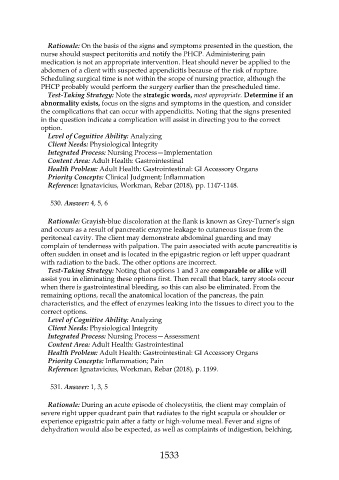Page 1533 - Saunders Comprehensive Review For NCLEX-RN
P. 1533
Rationale: On the basis of the signs and symptoms presented in the question, the
nurse should suspect peritonitis and notify the PHCP. Administering pain
medication is not an appropriate intervention. Heat should never be applied to the
abdomen of a client with suspected appendicitis because of the risk of rupture.
Scheduling surgical time is not within the scope of nursing practice, although the
PHCP probably would perform the surgery earlier than the prescheduled time.
Test-Taking Strategy: Note the strategic words, most appropriate. Determine if an
abnormality exists, focus on the signs and symptoms in the question, and consider
the complications that can occur with appendicitis. Noting that the signs presented
in the question indicate a complication will assist in directing you to the correct
option.
Level of Cognitive Ability: Analyzing
Client Needs: Physiological Integrity
Integrated Process: Nursing Process—Implementation
Content Area: Adult Health: Gastrointestinal
Health Problem: Adult Health: Gastrointestinal: GI Accessory Organs
Priority Concepts: Clinical Judgment; Inflammation
Reference: Ignatavicius, Workman, Rebar (2018), pp. 1147-1148.
530. Answer: 4, 5, 6
Rationale: Grayish-blue discoloration at the flank is known as Grey-Turner’s sign
and occurs as a result of pancreatic enzyme leakage to cutaneous tissue from the
peritoneal cavity. The client may demonstrate abdominal guarding and may
complain of tenderness with palpation. The pain associated with acute pancreatitis is
often sudden in onset and is located in the epigastric region or left upper quadrant
with radiation to the back. The other options are incorrect.
Test-Taking Strategy: Noting that options 1 and 3 are comparable or alike will
assist you in eliminating these options first. Then recall that black, tarry stools occur
when there is gastrointestinal bleeding, so this can also be eliminated. From the
remaining options, recall the anatomical location of the pancreas, the pain
characteristics, and the effect of enzymes leaking into the tissues to direct you to the
correct options.
Level of Cognitive Ability: Analyzing
Client Needs: Physiological Integrity
Integrated Process: Nursing Process—Assessment
Content Area: Adult Health: Gastrointestinal
Health Problem: Adult Health: Gastrointestinal: GI Accessory Organs
Priority Concepts: Inflammation; Pain
Reference: Ignatavicius, Workman, Rebar (2018), p. 1199.
531. Answer: 1, 3, 5
Rationale: During an acute episode of cholecystitis, the client may complain of
severe right upper quadrant pain that radiates to the right scapula or shoulder or
experience epigastric pain after a fatty or high-volume meal. Fever and signs of
dehydration would also be expected, as well as complaints of indigestion, belching,
1533

